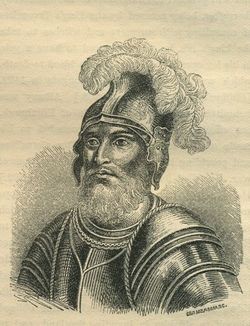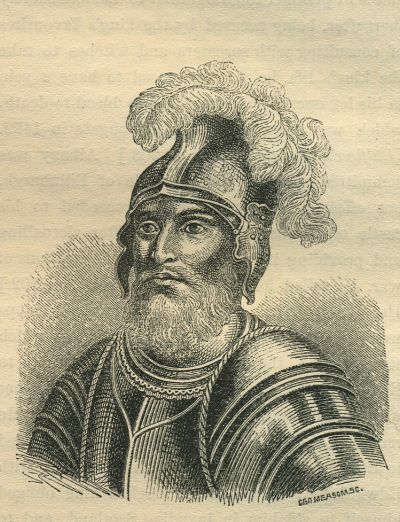Robert Stewart was the third son of the future King Robert II of Scotland (1316–1390) and of Elizabeth Mure of Rowallan. His parents' marriage was deemed uncanonical at first, which in some circles, gave their children and descendants the label of illegitimacy, but the granting of a papal dispensation in 1349 saw their remarriage and their children's legitimisation. Robert's grandfather was Walter Stewart, 6th High Steward of Scotland (1293–1326) and his father was the first monarch of the House of Stewart. His great-grandfather was Robert the Bruce (1274–1329), legendary victor of the Battle of Bannockburn.
Robert Stewart was raised in a large family with many siblings. His older brother John Stewart (1337–1406) became Earl of Carrick in 1368, and would later be crowned King of Scotland under the name Robert III.
In 1361 Stewart married Margaret Graham, Countess of Menteith (1334–1380), a wealthy divorcee who took Robert as her fourth husband. His sister-in-law's claim to the Earldoms of Menteith and Fife allowed him to assume those titles, becoming Earl of Menteith and Earl of Fife. In 1362 the couple had a son and heir, Murdoch Stewart, (1362–1425) who would in time inherit his father's titles and estates.
Stewart was responsible for the construction of Doune Castle, which remains largely intact today. When Stewart was created Earl of Menteith, he was granted the lands on which Doune Castle now stands. Building may have started any time after this, and the castle was at least partially complete in 1381, when a charter was sealed here.
After the death of his brother King Robert III, Albany ruled Scotland as regent. His young nephew, the future James I of Scotland, remained in exile and imprisonment in England for 18 years. Albany made little effort to secure the young Prince's ransom and return to Scotland, focusing his energies instead on securing his own power and interest.
Albany's political triumph did not settle his differences with the other members of the nobility, in particular Donald McDonald, 2nd Lord of the Isles, who in 1411 led an army of clansmen from the Northwest Highlands into open battle with the Stewarts. This conflict began when Albany had attempted to secure the Earldom of Ross for his second son John, despite McDonald's better claim.[12] At the Battle of Harlaw (known as "Red Harlaw" on account of its savagery)[13] on 24 July 1411, losses were heavy on both sides, though McDonald's eventual withdrawal allowed the Stewarts to claim a strategic victory.[14] The Stewart army was led by Albany's nephew, Alexander Stewart, Earl of Mar, who later sat on the jury of knights and peers which convicted Albany's son Murdoch Stewart, Duke of Albany and two of his sons of treason, virtually annihilating the Albany Stewarts.
Marriage and family
Stewart's son, John Stewart, 2nd Earl of Buchan, in a late-18th-century engraving. Buchan was killed at the Battle of Verneuil in 1424.
Albany married twice. Firstly, in 1361, he married Margaret Graham, Countess of Menteith, (1334–1380) a wealthy divorcee who took him as her fourth husband. His sister-in-law's claim to the Earldoms of Menteith and Fife allowed him to assume those titles after marriage. The couple had eight children, seven daughters and a son:
Lady Janet Stewart (married Sir David de Moubray)
Lady Mary Stewart (married Sir William Abernathy, 6th of Saltoun)
Lady Margaret Stewart (married to Sir John Swinton, 14th of that Ilk)
Lady Joan Stewart (married Sir Robert Stewart, 1st Lord of Lorne and had descendants)
Lady Beatrice Stewart (married Sir James Douglas of Balveny)
Lady Isobel Stewart (married to Alexander Leslie, 7th Earl of Ross and later to Walter de Haliburton, 1st Lord Haliburton of Dirleton and had descendants)
Murdoch Stewart, Duke of Albany (1362–1425) (Married Joan Douglas and later to Isabel, Countess of Lennox).
Lady Margery (married Sir Duncan Campbell, 1st Lord Campbell and had descendants)
Margaret died in 1380 and Albany subsequently married Muriella Keith, with whom he had three children:
John Stewart, 2nd Earl of Buchan (1381–1424); he fought in France against the English during the Hundred Years War, serving with distinction, but was killed at the Battle of Verneuil on 17 August 1424.
Robert Stewart, Earl of Ross, died without issue
Lady Elizabeth Stewart (married to Malcolm Fleming, ancestor of Malcolm Fleming, 3rd Lord Fleming)
The Duke of Albany died in 1420 in Stirling Castle and lies buried in Dunfermline Abbey in Fife. He was succeeded as Duke of Albany and Regent of Scotland by his son, Murdoch Stewart, Duke of Albany. But Murdoch would not enjoy his power for long. In 1425 the exiled King James, captive in England for 18 years, finally returned to Scotland, and executed Murdoch and most of his family for treason, causing the almost complete ruin of the Albany Stewarts.
Murdoch Stewart's sole surviving male heir was his youngest son, James the Fat, who fled to Ireland after a brief rebellion against the King over the arrest of his father and brothers. James remained in Ireland, unable to return, and died there in 1429. He was never able to inherit his father's titles, since they had been declared forfeit.
Albany's great-grandson, James "Beg" Stewart, (c. 1410-1470) would eventually secure a pardon from the King and return to Scotland, though the family would never recover their lost estates. James "Beg" Stewart is the ancestor of the Stewarts of Ardvorlich on Lochearnside, whose family history is recounted by Sir Walter Scott in A Legend of Montrose.
Robert Stewart was the third son of the future King Robert II of Scotland (1316–1390) and of Elizabeth Mure of Rowallan. His parents' marriage was deemed uncanonical at first, which in some circles, gave their children and descendants the label of illegitimacy, but the granting of a papal dispensation in 1349 saw their remarriage and their children's legitimisation. Robert's grandfather was Walter Stewart, 6th High Steward of Scotland (1293–1326) and his father was the first monarch of the House of Stewart. His great-grandfather was Robert the Bruce (1274–1329), legendary victor of the Battle of Bannockburn.
Robert Stewart was raised in a large family with many siblings. His older brother John Stewart (1337–1406) became Earl of Carrick in 1368, and would later be crowned King of Scotland under the name Robert III.
In 1361 Stewart married Margaret Graham, Countess of Menteith (1334–1380), a wealthy divorcee who took Robert as her fourth husband. His sister-in-law's claim to the Earldoms of Menteith and Fife allowed him to assume those titles, becoming Earl of Menteith and Earl of Fife. In 1362 the couple had a son and heir, Murdoch Stewart, (1362–1425) who would in time inherit his father's titles and estates.
Stewart was responsible for the construction of Doune Castle, which remains largely intact today. When Stewart was created Earl of Menteith, he was granted the lands on which Doune Castle now stands. Building may have started any time after this, and the castle was at least partially complete in 1381, when a charter was sealed here.
After the death of his brother King Robert III, Albany ruled Scotland as regent. His young nephew, the future James I of Scotland, remained in exile and imprisonment in England for 18 years. Albany made little effort to secure the young Prince's ransom and return to Scotland, focusing his energies instead on securing his own power and interest.
Albany's political triumph did not settle his differences with the other members of the nobility, in particular Donald McDonald, 2nd Lord of the Isles, who in 1411 led an army of clansmen from the Northwest Highlands into open battle with the Stewarts. This conflict began when Albany had attempted to secure the Earldom of Ross for his second son John, despite McDonald's better claim.[12] At the Battle of Harlaw (known as "Red Harlaw" on account of its savagery)[13] on 24 July 1411, losses were heavy on both sides, though McDonald's eventual withdrawal allowed the Stewarts to claim a strategic victory.[14] The Stewart army was led by Albany's nephew, Alexander Stewart, Earl of Mar, who later sat on the jury of knights and peers which convicted Albany's son Murdoch Stewart, Duke of Albany and two of his sons of treason, virtually annihilating the Albany Stewarts.
Marriage and family
Stewart's son, John Stewart, 2nd Earl of Buchan, in a late-18th-century engraving. Buchan was killed at the Battle of Verneuil in 1424.
Albany married twice. Firstly, in 1361, he married Margaret Graham, Countess of Menteith, (1334–1380) a wealthy divorcee who took him as her fourth husband. His sister-in-law's claim to the Earldoms of Menteith and Fife allowed him to assume those titles after marriage. The couple had eight children, seven daughters and a son:
Lady Janet Stewart (married Sir David de Moubray)
Lady Mary Stewart (married Sir William Abernathy, 6th of Saltoun)
Lady Margaret Stewart (married to Sir John Swinton, 14th of that Ilk)
Lady Joan Stewart (married Sir Robert Stewart, 1st Lord of Lorne and had descendants)
Lady Beatrice Stewart (married Sir James Douglas of Balveny)
Lady Isobel Stewart (married to Alexander Leslie, 7th Earl of Ross and later to Walter de Haliburton, 1st Lord Haliburton of Dirleton and had descendants)
Murdoch Stewart, Duke of Albany (1362–1425) (Married Joan Douglas and later to Isabel, Countess of Lennox).
Lady Margery (married Sir Duncan Campbell, 1st Lord Campbell and had descendants)
Margaret died in 1380 and Albany subsequently married Muriella Keith, with whom he had three children:
John Stewart, 2nd Earl of Buchan (1381–1424); he fought in France against the English during the Hundred Years War, serving with distinction, but was killed at the Battle of Verneuil on 17 August 1424.
Robert Stewart, Earl of Ross, died without issue
Lady Elizabeth Stewart (married to Malcolm Fleming, ancestor of Malcolm Fleming, 3rd Lord Fleming)
The Duke of Albany died in 1420 in Stirling Castle and lies buried in Dunfermline Abbey in Fife. He was succeeded as Duke of Albany and Regent of Scotland by his son, Murdoch Stewart, Duke of Albany. But Murdoch would not enjoy his power for long. In 1425 the exiled King James, captive in England for 18 years, finally returned to Scotland, and executed Murdoch and most of his family for treason, causing the almost complete ruin of the Albany Stewarts.
Murdoch Stewart's sole surviving male heir was his youngest son, James the Fat, who fled to Ireland after a brief rebellion against the King over the arrest of his father and brothers. James remained in Ireland, unable to return, and died there in 1429. He was never able to inherit his father's titles, since they had been declared forfeit.
Albany's great-grandson, James "Beg" Stewart, (c. 1410-1470) would eventually secure a pardon from the King and return to Scotland, though the family would never recover their lost estates. James "Beg" Stewart is the ancestor of the Stewarts of Ardvorlich on Lochearnside, whose family history is recounted by Sir Walter Scott in A Legend of Montrose.
Family Members
-
![]()
Robert Stewart III
1337–1406
-
Margaret Stewart MacDonald
1342–1417
-
![]()
Alexander "The Wolf Of Badenoch" Stewart
1343–1394
-
![]()
Princess of Scotland Isabella Eupheme Stewart Douglas
1348–1410
-
Marjorie Stewart Dunbar
1348–1417
-
![]()
Elizabeth "(Princess of Scotland)" Stewart De La Haye of Errol
1348–1389
-
![]()
Lady Jean Stewart Lyon
1350–1404
-
Walter Stewart
unknown–1362
Advertisement
Explore more
Sponsored by Ancestry
Advertisement

















